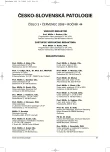Spontaneus Abortion Caused by Listeria monocytogenes – Report of Three Cases
Authors:
M. Ježová 1; K. Múčková 1; P. Koukalová 2
Authors‘ workplace:
Ústav patologie, Lékařská fakulta Masarykovy Univerzity a Fakultní nemocnice, Brno
1; Oddělení klinické mikrobiologie, Lékařská fakulta Masarykovy Univerzity a Fakultní nemocnice, Brno
2
Published in:
Čes.-slov. Patol., 44, 2008, No. 3, p. 71-74
Category:
Original Article
Overview
This paper describes three cases of spontaneous abortion caused by Listeria monocytogenes which were diagnosed during the outbreak of listeriosis in late 2006. Both clinical and morphological features were highly consistent. The abortion between 19 and 20 weeks of gestation was preceded by high maternal fever. The fetal disease was miliary widespread with involvement of adrenals, liver and lungs in particular. There was always present a pustular rash. Histological examination of the placentas revealed acute chorioamnionitis with massive growth of gram-positive rods in the amnion in all cases. Acute villitis and intervillous microabscesses were additionally noted in one case. The diagnosis in all reported cases was not established until fetal autopsy. The final diagnosis was confirmed by microbiological examination using samples submitted during the autopsy examination.
Key words:
Listeria monocytogenes – listeriosis – abortion
Sources
1. Abram, M., Dorić, M.: Primary Listeria monocytogenes infection in gestating mice. Folia microbiol., 42, 1997, s. 65 – 71.
2. Aureli, P., Fiorucci, G.C., Caroli, D. et al.: An outbreak of febrile gastroenteritis associated with corn contaminated by Listeria monocytogenes. N. Engl. J. Med., 342, 2000, s. 1236 – 1241.
3. Bakardjiev, A.I., Stacy, B.A., Fisher, S.J., Portnoy, D.A.: Listeriosis in the pregnant guiney pig: a model of vertical transmission. Infect. Immun., 72, 2004, s. 489 – 497.
4. Bakardjiev, A.I., Theriot, J.A., Portnoy, D.A.: Listeria monocytogenes traffics from maternal organs to the placenta and back. PLoS Pathog., 2, 2006, 623 -631.
5. Bernischke, K., Kaufmann, P.: Pathology of the human placenta, 4th ed., New York: Springer Verlag , 2000, s. 591 – 619.
6. Bille, J., Blanc, D.S., Schmid, H. et al.: Outbreak of human listeriosis associated with tomme cheese in northwest Switzerland, 2005. Euro. Surveill., 11, 2006, s. 91 – 93.
7. Frederiksen, B., Samuelsson, S.: Feto-maternal listeriosis in Denmark 1981 – 1988. J. Infect., 24, 1992, s. 277 – 287.
8. Gellin, B.G., Broome, C.V., Bibb, W.F. et al.: The epidemiology of listeriosis in the United States – 1986. Listeriosis study group. Am . J. Epidemiol., 133, 1991, s. 392 – 401.
9. Grif, K., Patscheider, G., Dierich, M.P., Allerberger, F.: Incidence of fecal carriage of Listeria monocytogenes in three healthy volunteers: a one- year prospective stool survey. Eur. J. Clin. Microbiol. Infect. Dis., 22, 2003, s. 16 - 20.
10. Jamieson, D.J., Theiler, R.N., Rasmussen, S.A.: Emerging infections and pregnancy. Emerg. Infect. Dis., 12, 2006, s. 1638 – 1642.
11. Kraus, F.T., Redline, R.W., Gersell, D.J., Nelson, D.M., Dicke, J.M.: Placental Pathology. 1st ed., Washington DC: American Registry of Pathology, 2004. s- 87 – 90.
12. Lallemand, A.V., Gailard, D.A., Paradis, P.H., Chippaux, C.G.: Fetal listeriosis during the second trimester of gestation. Pediatr. Pathol., 12, 1992, s. 665 – 671.
13. Le Monnier, A., Join-Lambert, O.F., Jaubert, F., Berche, P., Kayal, S.: Invasion of the placenta during murine listeriosis. Infect. Immun., 74, 2006, s. 663 – 672.
14. Leciut, M.: Understanding how Listeria monocytogenes targets and crosses host barriers. Clin. Microbiol. Infect., 11, 2005, s. 430 – 436.
15. Linnan, M.J., Mascola, L, Lou, X.D. et al.: Epidemic listeriosis associated with Mexican-style cheese. N. Engl. J. Med., 319, 1998, s. 823 – 828.
16. MacDonald, P.D., Whitwam, R.E., Boggs, J.D. et al.: Outbreak of listeriosis among Mexican immigrants as a result of consumption of illicitly produced Mexican- style cheese. Clin. Infect. Dis., 40, 2005, s. 677 – 682.
17. Murray, E.G.D., Webb, r.A., Swann, H.B.R.: A disease of rabbits characterized by large mononuclear leucocytosis caused by hitherto undescribed bacillus Bacterium monocytogenes. J. Pathol. Bacteriol., 29, 1926, s. 407 – 439.
18. Nolla-Salas, J., Bosch, J., Gasser, I. et al.: Perinatal listeriosis: a population- based multicenter study in Barcelona, Spain (1990 – 1996). Am. Perinatol., 15, 1998, s. 461 – 467.
19. Nyfeldt, A.: Etiologie de la mononucléose infectieuse. Soc. Biol. ,101, 1929, s. 590 – 591.
20. Redline, R.W., Lu, C.Y.: Role of local immunosupresion in murine fetoplacental listeriosis. J. Clin. Investig., 79, 1987, s. 1234 – 1441.
21. Reiss, H.J., Potel, J., Kregs, H.: Granulomatosis infentiseptice. Eine allgemeinininfektion bei Neugeboren and Säuglingen mit miliaren Granulomen. Z. Ges. Inn. Med., 6, 1951, s. 451 – 457.
22. Schlech, W.F., Lavigne, P.M., Bortolussi, R.A. et al.: Epidemic listeriosis: evidence for transmission by food. N. Engl. J. Med., 308, 1983, s. 203 – 206.
23. Topalovski, M., Yang, S., Boonpasat, Y.: Listeriosis of the placenta: clinocopathologic study of seven cases. Am. J. Obstet. Gynecol., 169, 1993, s. 616 – 620.
24. Vasquéz – Boland, J.A., Kuhn, M., Berche, P. et al.: Listeria pathogenesis and molecular virulence determinants. Clin. Microbiol. Rev., 14, 2001, s. 584 – 640.
25. Vít, M., Olejník, L., Dlhý, J. et al.: Předběžná zpráva o výskytu listeriózy v České republice v roce 2006. Zprávy CEM, 16, 2007, s. 26 – 28.
26. www.muni.cz/atlases
27. Yamazaki, K., Price, J.T., Altshuher, G.: A placental view of the diagnosis and pathogenesis of congenital listeriosis. Am. J. Obstet. Gynecol., 129, 1977, s. 703 – 705.
Labels
Anatomical pathology Forensic medical examiner ToxicologyArticle was published in
Czecho-Slovak Pathology

2008 Issue 3
Most read in this issue
- Thrombotic Microangiopathies: Thrombotic Thrombocytopenic Purpura (TTP) and Hemolytic Uremic Syndrome (HUS). Morphological Features, Differential Diagnosis, and Pathogenesis. Review Article
- Spontaneus Abortion Caused by Listeria monocytogenes – Report of Three Cases
- Expression of CD34 and CD117 in Juxtaglomerular Cell Tumor of Kidney
- Fibrosis Identified in the Bone Marrow Biopsies of Patients with Essential Thrombocythemia: its Incidence and Significance for the Differential Diagnostic Considerations
